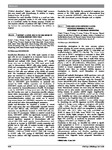PO-511 High miR-9 levels represent a novel prognostic biomarker to predict development of malignant meningioma
| dc.contributor.author | Baiz, D | |
| dc.contributor.author | Negroni, C | |
| dc.contributor.author | Ferluga, S | |
| dc.contributor.author | Ercolano, E | |
| dc.contributor.author | Adams, Claire | |
| dc.contributor.author | Hanemann, Clemens Oliver | |
| dc.date.accessioned | 2023-02-14T12:33:07Z | |
| dc.date.available | 2023-02-14T12:33:07Z | |
| dc.date.issued | 2018-06 | |
| dc.identifier.issn | 2059-7029 | |
| dc.identifier.uri | http://hdl.handle.net/10026.1/20354 | |
| dc.description.abstract |
Introduction Meningioma is the most common primary tumour affecting the central nervous system; it is classified as benign (WHO I,~80%), atypical (WHO II,~15%–20%) and anaplastic/malignant (WHO III,~1%–3%). The 3 year recurrence rate in WHO I meningioma is estimated in about 50% and it is much greater in WHO II and III tumours. MicroRNAs (miRNAs) represent a large class of small RNAs driving regulation of gene expression at post-transcriptional level and playing a role in cell proliferation, differentiation, apoptosis and carcinogenesis. Several studies showed that miRNAs are involved in tumour progression and therefore proposed as diagnostic tools. Here, we evaluated miRNAs signature in meningioma to identify novel biomarkers of tumour progression. Material and methods Meningioma (MN) specimens were collected from consented patients, according to the ethics. The 96-miRNA profiling was performed using the QuantimirTM Cancer MicroRNA qPCR Array (System Biosciences, UK) following the instructions of the supplier. Validation studies were achieved using TaqMan MicroRNA reagents (Applied Biosystems). Bioinformatic analysis was done using the NormFinder software and in silico studies were performed using the following datasets for putative miRNA targets: TargetScanHuman7.1, DIANATOOLS microT-CDS, mirDIP and the UTRdb tool. Probability (p) values were calculated using the Student’s t-Test, led by the GraphPad Prism 5.01 (p<0.05±SEM). Results and discussions We established a new miRNA dataset by identifying six miRNA signatures (p<0.01) differentially regulated in benign versus malignant meningioma cells (miR-9, 10b, 125b, 143,–145 and 199). Validation studies by qPCR confirmed that the miR-9 was upregulated in malignant KT21-MG1 cells (10.71 folds; Log2 scale, p=0.0006) and WHO III tissues (3.75 folds versus WHO I=0, Log2 scale, p=0.044). Finally, highly stringent in silico studies suggested that the miR-9 targets and downregulates the ubiquitin-protein ligase E3C (UBE3C), as confirmed by proteomic analysis in malignant KT21-MG1 and IOMM-Lee cells. Conclusion In this study, we identified the miR-9 as significantly upregulated in WHO III tumour-derived meningioma cells and tissues when compared to lower grades. Since miR-9 targets the ubiquitin-protein ligase E3C, involved in the ubiquitin-proteasome pathway and therefore regulating protein homeostasis, this protein, together with miR-9, could represent potential novel diagnostic and/or prognostic biomarkers in meningioma. | |
| dc.format.extent | A430-A430 | |
| dc.language | en | |
| dc.language.iso | en | |
| dc.publisher | Elsevier BV | |
| dc.subject | Rare Diseases | |
| dc.subject | Genetics | |
| dc.subject | Biotechnology | |
| dc.subject | 2.1 Biological and endogenous factors | |
| dc.subject | 4.1 Discovery and preclinical testing of markers and technologies | |
| dc.subject | 4.2 Evaluation of markers and technologies | |
| dc.subject | Cancer | |
| dc.title | PO-511 High miR-9 levels represent a novel prognostic biomarker to predict development of malignant meningioma | |
| dc.type | journal-article | |
| plymouth.issue | Suppl 2 | |
| plymouth.volume | 3 | |
| plymouth.publication-status | Published | |
| plymouth.journal | ESMO Open | |
| dc.identifier.doi | 10.1136/esmoopen-2018-eacr25.1012 | |
| plymouth.organisational-group | /Plymouth | |
| plymouth.organisational-group | /Plymouth/Faculty of Health | |
| plymouth.organisational-group | /Plymouth/Faculty of Health/Peninsula Medical School | |
| plymouth.organisational-group | /Plymouth/REF 2021 Researchers by UoA | |
| plymouth.organisational-group | /Plymouth/REF 2021 Researchers by UoA/UoA01 Clinical Medicine | |
| plymouth.organisational-group | /Plymouth/Research Groups | |
| plymouth.organisational-group | /Plymouth/Research Groups/Institute of Translational and Stratified Medicine (ITSMED) | |
| plymouth.organisational-group | /Plymouth/Research Groups/Institute of Translational and Stratified Medicine (ITSMED)/CBR | |
| plymouth.organisational-group | /Plymouth/Research Groups/Plymouth Institute of Health and Care Research (PIHR) | |
| plymouth.organisational-group | /Plymouth/Users by role | |
| plymouth.organisational-group | /Plymouth/Users by role/Academics | |
| plymouth.organisational-group | /Plymouth/Users by role/Researchers in ResearchFish submission | |
| dcterms.dateAccepted | 2018-06-29 | |
| dc.rights.embargodate | 2023-2-15 | |
| dc.rights.embargoperiod | Not known | |
| rioxxterms.versionofrecord | 10.1136/esmoopen-2018-eacr25.1012 | |
| rioxxterms.licenseref.uri | http://www.rioxx.net/licenses/all-rights-reserved | |
| rioxxterms.type | Journal Article/Review |


